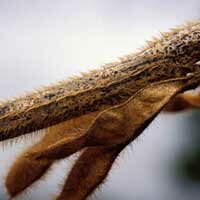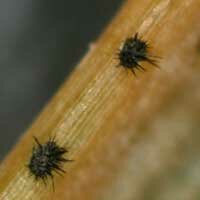
-
Soybean Diseases
- Asian Rust
- Anthracnose
- Bacterial Blight
- Bacterial Pustule
- Bean Pod Mottle Virus
- Brown Stem Rot
- Cercospora Leaf Blight
- Charcoal Rot
- Downy Mildew
- Frogeye Leaf Spot
- Green Stem Syndrome
- Iron Deficiency Chlorosis
- Phytophthora Root & Stem Rot
- Powdery Mildew
- Rhizoctonia
- Seedling Diseases
- Septoria (Brown Spot)
- SCN (Soybean Cyst Nematode)
- Soybean Mosaic Virus
- Stem Canker
- Sudden Death Syndrome
- Viruses
- White Mold
- Soybean Pests
- Diagnostic Help
- Field Trials
- Soybean Library
Your Soybean Checkoff.
Delivering Results.
Illinois
Indiana
Iowa
Kansas
Michigan
Minnesota
Missouri
Nebraska
North Dakota
Ohio
South Dakota
Wisconsin
Anthracnose
 |
| Anthracnose diseases are characterized by sunken black lesions on stems, leaves and pods. Click on image to view a close-up version. Photo credit: University of Minnesota |
Anthracnose in soybean is caused by the fungus Colletotrichum dematium var. truncatum, and several related species. It is present in soybean fields to some degree every season, but it generally does not cause severe symptoms or yield loss in the Midwest. The anthracnose pathogen Colletotrichum graminicola causes leaf blight and stalk rot of corn.
The fungus can infect stems, pods, and leaves of soybean, often without symptoms until weather conditions are warm and moist. It can also be a secondary pathogen on wounded plant tissue.
Disease cycle
The anthracnose pathogen survives as mycelium or spores on infested crop residue and on seed. The fungus can cause damping-off (decay of seed or seedlings) if infested seed is planted. The fungus can establish itself in seedlings without symptoms until the plants begin to flower.
Leaf infections and secondary infections later in the season develop mainly from wind or rain-blown spores produced on infested plant residue.
High plant populations, warm temperatures, and wet canopies favor disease development.
Agronomic Impact
Anthracnose typically has minimal effects on yield, but it can occasionally reduce stands, yields, and seed quality. If pod infection is severe, they may produce no seed, or seed that is small, brown and moldy. Infected seeds may not germinate.
Symptoms and scouting
Symptoms of anthracnose are most commonly seen during the reproductive growth stages. Symptoms on foliage, stems, petioles or pods typically appear as dark irregular lesions covered by small black dots (acervuli), which are the fruiting bodies of the fungus. Tiny black spines may be evident when viewed with 10X magnification.
When pods are infected, the fungus may completely fill the cavity and no seeds are produced, or fewer, smaller seed may form. Seed that does form may appear brown, moldy and shriveled or may look normal.
The dark, irregular lesions caused by anthracnose fungi often resemble those caused by the pod and stem blight pathogen, Diaporthe phaseolorum var. sojae Anthracnose and pod and stem blight often occur together on the same plants late in the season.
Management
- Soybean varieties differ in their susceptibility to anthracnose. Consult with your seed dealer if anthracnose is a persistent problem.
- Anthracnose is seed-borne, so it is particularly effective to plant high-quality seed that is certified pathogen-free. Do not use seed from infected plants. Not all infested seed is discolored.
- Fungicide seed treatments can improve germination and seedling vigor of seed lots that may be infected with Colletotrichum.
- Foliar fungicides applied after bloom can prevent seed infection.
- The fungus can survive from year to year in crop debris. Prevent pathogen build-up by rotating crops and burying or shredding soybean residue to promote rapid breakdown.
More resources
Antthracnose of Soybean - Minnesota Crop Diseases, University of Minnesota Extension
Anthracnose of Soybean - University of Nebraska

